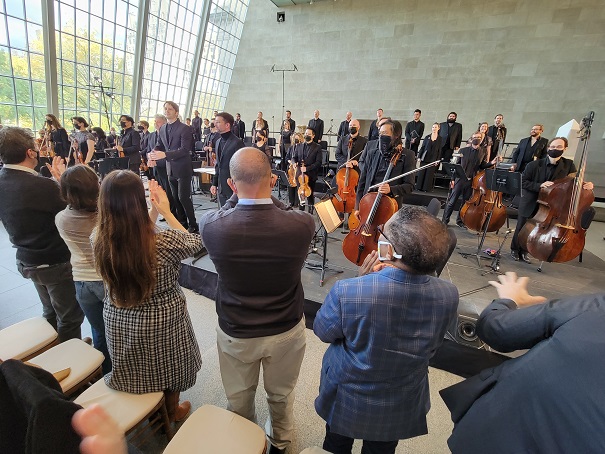Concert Diary: Arvo Pärt at the Met Museum
October 31, 2021
New York, N.Y.
The program notes for the concert celebrating the music of Arvo Pärt said “The program will be performed without applause,” which pleased me just fine. I’d be happy to see the rule against applauding between movements extended to the pauses between compositions. Let the music sit in our heads for a little while before the nonsensical whooping and the white noise of clapping hands. (Which of course I participate in, for I am a champion whooper.)
I was skeptical that such a program note would work, but it did. Nine compositions played over the course of seventy-plus minutes and not a single clap. The effect was more eerie than I imagined it would be, and at the very end about a minute passed before the pent-up applause poured forth and the audience jumped to their feet. In the following photo, the unmasked chorus is at the rear, the masked musicians in front of them, and in the near foreground, people sitting in reserved seats in front of me:
The Estonian composer Arvo Pärt is now 86 years old; his music has become widely known in the West since the recording of Tabula Rasa on ECM Records in 1984. Pärt is considered a minimalist composer, but with a difference. His music is not the exhilerating jubilant minimalism of Philip Glass, or the syncopated lyrical minimalism of Steve Reich, or the anarchic trippy minimalism of Terry Riley, but a minimalism more devout, contemplative, and often overtly religious. Indeed, Pärt might be the most spiritually oriented composer since Messiaen. His music is always quite slow (at least in my experience) but when it works, expectation is suspended and time is stopped.
The concert was held in the Metropolitan Museum’s Sackler Wing, named after the family that manufactured OxyContin, responsible for untold misery and death throughout America. It’s the room where the famous Temple of Dendur resides, and while it might seem like a splendid setting for a concert, the acoustics are not conducive (which required some amplication to compensate), and the seats are horribly uncomfortable.
But the music? Well!
I thought I knew Pärt’s famous 1977 composition Fratres (Brothers), but the version I was most familiar with is for solo violin and piano. Here it was performed by violin and string orchestra with a little strategic percussion: bass drum and (I believe) wood blocks. This was a revelation, for the similarity in timbre among the strings gave the composition a more coherent feel rather than the stark contrast between violin and piano.
Next were two fairly recent vocal works, Vater Unser for countertenor and string orchestra, and The Deer’s Cry for a cappella chorus. Unfortunately, the museum didn’t bother to provide texts for these works in their program notes, which weren’t even printed but only available online. Nor did the program notes contain any information about the works, such as when they were composed, or what they might be about.
I loved hearing the string orchestra play Silouan’s Song, in which sparse melancholy phrases build into longer melodic lines that would then stop and pause for a moment. Salve Regina for chorus, string orchestra, and celesta rose in joy and triumph towards the end, but drew back into a soft extended coda. Summa for string orchestra used simple melodic motifs that combined in intricate Bachian ways.
Next up was a world premiere: O Holy Father Nicholas for a cappella chorus with short passages for two soprano and two alto soloists. Although the text was apparently in English, and I could hear the Trinitarian formula at the beginning and end, much of the inbetween was incomprehensible. I suspect that Father Nicholas is the man more familiarly known as Saint Nicholas, but if this composition is actually Christmas music or not, I have no idea.
The concert ended with Pärt’s 1977 Cantus in Memory of Benjamin Britten (who had died the previous year), which uses the string orchestra to play an elegy against a tolling bell that increasingly gets louder. This is a very effective work. They ended with Da Pacem Domine, a 2004 piece for chorus and strings featuring shifting harmonies and textures.
If I were to give out grades, I’d give the music and musicians an A+ but the Met Museum gets a C- for multiple offenses: failing to provide us with adequate program notes, putting us in uncomfortable chairs, and forcing us to look at an entranceway emblazoned with the disgraced name of Sackler for the duration of an otherwise wonderful concert.
